2019 MERCEDES-BENZ SLC ROADSTER ESP
[x] Cancel search: ESPPage 28 of 306
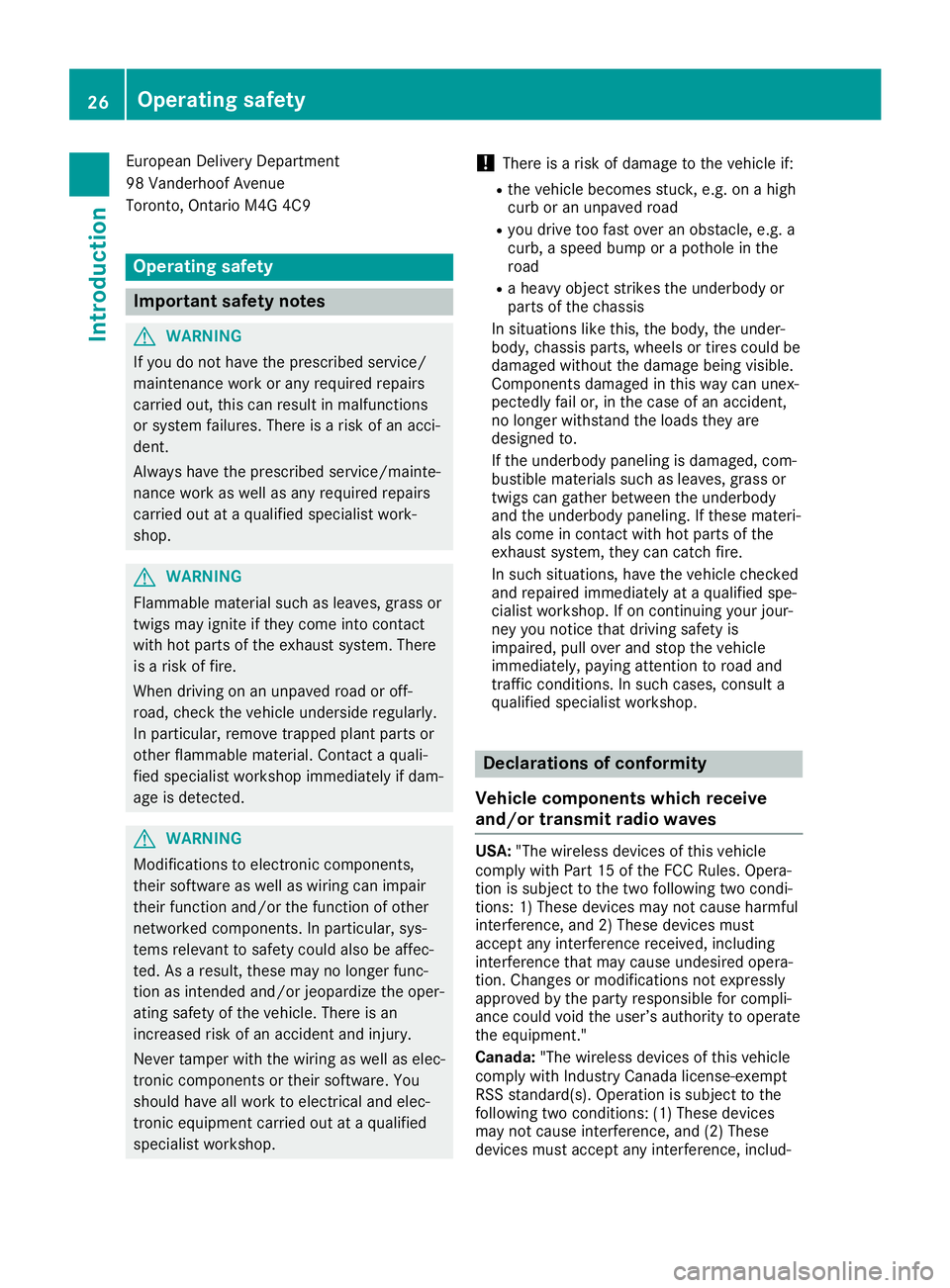
Eur
opeanDel iveryDep artment
98 Vande rhoofAvenu e
To ronto ,Onta rioM4G 4C9 Ope
ratin gsaf ety Impo
rtant safety notes G
WA
RNING
If yo udo not have the prescri bedser vice/
ma inte nance workor any required repairs
car riedou t,thi scan resultin ma lfunctio ns
or system failur es. The reisaris kof an acc i-
de nt.
Alw aysha ve the prescri bedser vice/ma inte-
nance workas wellas any required repairs
car riedou tat aqu alifi ed speci alistwo rk-
sho p. G
WA
RNING
Fla mma ble ma teri alsuch asleav es, grassor
twi gsma yig nite ifthe ycome intoconta ct
wi th hot parts ofthe exhaust system .The re
is aris kof fire.
Wh endrivin gon anunp aved roa dor off-
roa d,che ckthe vehicleund erside reg ular ly.
In partic ular ,rem ove trapped plant parts or
othe rfla mma ble ma teri al.Co ntact aqu ali-
fie dsp eci alistwo rksh opimm ediatel yif da m-
ag eis de tecte d. G
WA
RNING
Mod ificati ons toelectro niccomp onents,
the irsof twa reas wellas wirin gcan impair
the irfunctio nand /or thefunctio nof othe r
netw orkedcomp onents. Inpartic ular ,sy s-
tems releva ntto safety couldalso be affec-
ted .As ares ult, the sema yno longe rfu nc-
tio nas inte ndedand /or jeopardi ze the oper-
ati ng safety ofthe vehicle. The reisan
incr eased riskof an acc ident and injury.
Nev ertam perwi th the wirin gas wellas elec-
troni ccomp onents orthe irsof twa re.You
sho uld ha ve allwo rkto electri caland elec-
troni ceq uipme ntcar riedou tat aqu alifi ed
sp eci alistwo rksh op. !
The
reisaris kof dama getothe vehicleif:
R the vehiclebe come sstu ck, e.g.on ahigh
cur bor an unp aved roa d
R youdri ve too fast ove ran obsta cle,e.g .a
cur b,asp ee dbu mp orapo thol ein the
roa d
R ahe avyob ject strikes theunderbodyor
pa rts ofthe chassis
In situa tions like this,the body,the under-
bo dy,cha ssispa rts, wheelsor tire scou ldbe
da ma gedwi thou tthe dama gebeing visible.
Co mpo nents dama gedin thi swa ycan unex-
pe cted lyfailor, inthe caseof an acc ident,
no longe rwi thsta ndthe load sthe yar e
de signe dto.
If the underbodypa nel ing isda ma ged, com-
bu stible ma teri alssu ch asleav es, grassor
twi gscan gathe rbe twe enthe underbody
and theunderbodypa nel ing.If the sema teri -
al scome inconta ctwith hot parts ofthe
exh aust system ,the ycan catc hfir e.
In such situa tions, have the vehicleche cked
and repaired imm ediatel yat aqu alifi ed spe-
cia list wo rksh op.If on conti nuing your jou r-
ney younoti cetha tdri vin gsa fety is
imp aired ,pu llove rand stop thevehicle
imm ediatel y,pa ying atte ntionto roa dand
tra fficcond itions. Insuch cas es, cons ulta
qu alifi ed speci alistwo rksh op. De
clarati onsof confo rmity
Veh icle co mpon ents wh ich rec eive
and/ ortrans mitradio waves US
A:"The wirel ess devic es ofthisveh icle
comp lywith Part15 ofthe FCC Rules. Op era -
tio nis su bje ctto the two followi ng two cond i-
tio ns: 1)The sedevic es ma ynot causeharmfu l
inte rferenc e,and 2)The sedevic es mu st
acc eptany interferenc erece ived,incl uding
inte rferenc etha tma ycau seund esired opera -
tio n.Ch ang esormod ificati ons notexpressly
ap pro ved bythe party responsi ble for comp li-
ance couldvoi dthe user’ sau thor itytoopera te
the equipme nt."
Ca nada :"T he wirel ess devic es ofthisveh icle
comp lywith Indu stry Canad alicens e-exemp t
RSS standa rd(s).Op era tionis su bje ctto the
fol lowi ng two cond itions: (1)The sedevic es
ma ynot causeinte rferenc e,and (2)The se
de vic es mu stacc eptany interferenc e,incl ud- 26
Ope
ratin gsaf etyIntroduc tion
Page 29 of 306
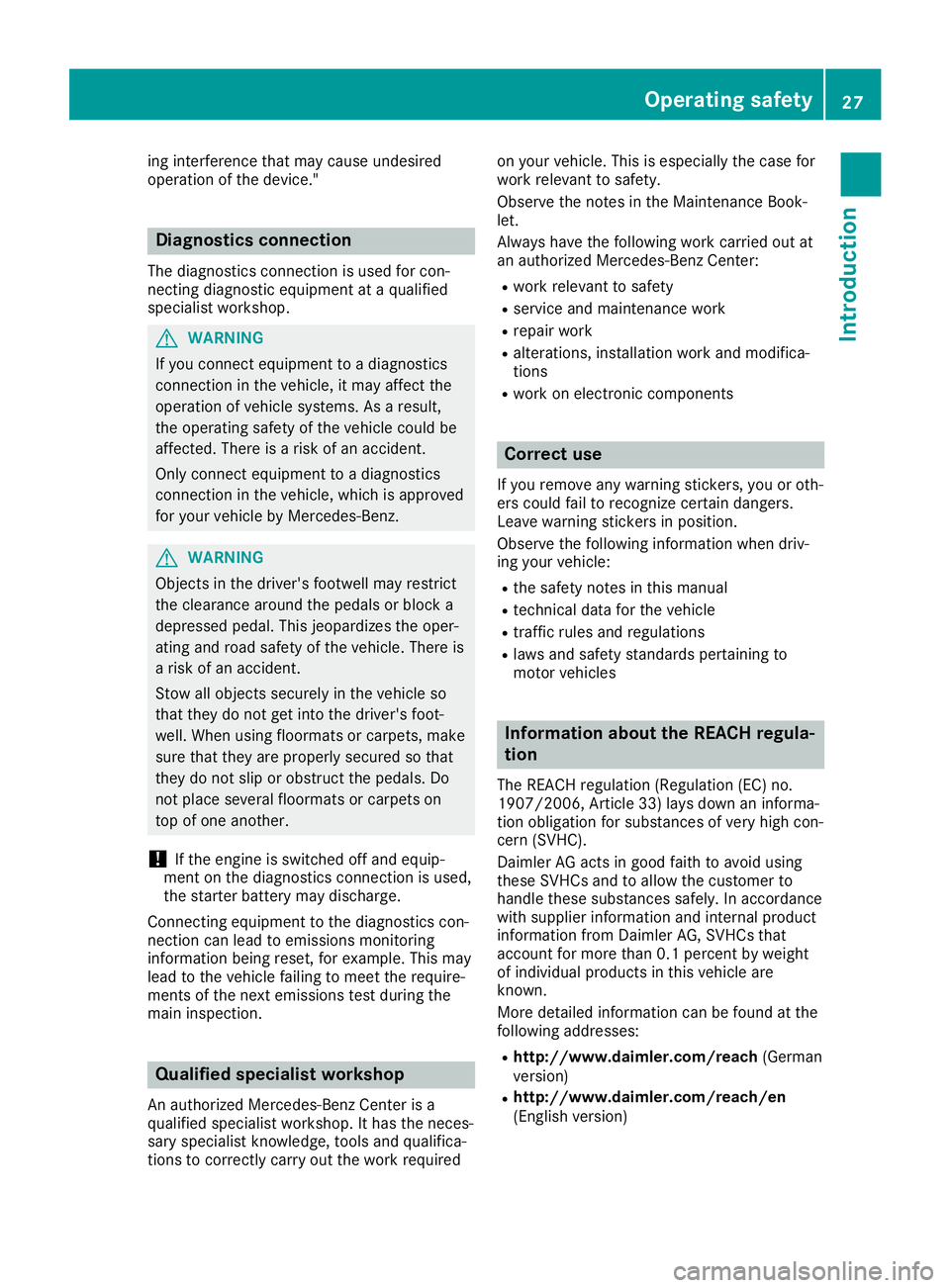
ing
interfe rencethat may cause undesir ed
operat ionofthe devic e." Diagnost
icsconnection
The diagno sticscon nection isused forcon -
nec tingdiagno sticequipmen tat aqualified
spec ialist workshop. G
WARN
ING
If you connectequipmen tto adiagno stics
con nection inthe vehic le,itmay affec tthe
operat ionofvehic lesyst ems. Asaresult ,
the operat ingsafet yof the vehic lecould be
affec ted.There isarisk ofan acc ident .
Only connectequipmen tto adiagno stics
con nection inthe vehic le,which isapprov ed
for your vehic leby Merc edes- Benz. G
WARN
ING
Obj ectsin the drive r'sfoot well may restrict
the clearan cearound thepedals orblock a
depres sedpedal. Thisjeopardiz esthe oper-
atin gand road safetyof the vehic le.There is
a risk ofan acc ident .
St ow allobje ctssecur elyinthe vehic leso
that theydo not getintothe drive r'sfoot -
well. When usingfloormats orcarpe ts,make
sure thattheyare proper lysecur edsothat
the ydo not slip orobst ruct thepedals. Do
not place severalfloor mats orcarpe tson
top ofone anot her.
! If
the engin eis switc hedoffand equip-
men ton the diagno sticscon nection isused,
the star terbatt erymay disch arge.
Conn ecting equipmen tto the diagno sticscon -
nec tion canlead toemiss ionsmonitoring
inf ormat ionbeing reset,for exam ple.This may
lead tothe vehic lefailing tomeet therequire -
men tsof the nextemiss ionstestdurin gthe
main inspection. Qua
lified speciali stworksh op
An author izedMerc edes- BenzCent erisa
qualified specialist workshop. Ithas theneces-
sary specialist knowledge, toolsand qualifica-
tion sto cor rectlycarr yout thework require don
your vehic le.This isespec iallythecase for
work relevanttosafet y.
Obser vethe notesinthe Maint enanceBook -
let.
Always havethefollowin gwork carriedout at
an author izedMerc edes- BenzCent er:
R work relevanttosafet y
R serv iceand maint enancework
R repair work
R alter ation s,inst allation workandmodif ica-
tion s
R work onelect roniccom pone nts Corr
ectuse
If you remo veany warnin gstic kers,you oroth -
ers could failtorec ogn izecertain danger s.
Leave warnin gstic kersin posit ion.
Obser vethe followin ginf ormat ionwhen driv-
ing your vehic le:
R the safet ynot esinthis manual
R tec hnic aldata forthe vehic le
R traffic rules andregulat ions
R laws andsafet ystan dards pertainin gto
mot orvehic les Inform
ation about theREACH regula-
tion
The REACHregulat ion(Regulation (EC)no.
190 7/200 6,Artic le33) lays down aninforma-
tion obligat ionforsubst ancesofvery high con-
cer n(SVH C).
Daimle rAG actsin good faithto avoid using
the seSVH Csand toallow thecust omer to
handle thesesubst ancessafely. Inacc ordan ce
with supplier informat ionand intern alproduc t
inf ormat ionfromDaimle rAG, SVH Csthat
acc ount formore than0.1perc entbyweight
of indiv idual produc tsinthis vehic leare
kn own.
More detailed informat ioncan befoun dat the
followin gaddress es:
R http://www.d aimler.com/r each(German
vers ion)
R http://www.d aimler.com/r each/en
(En glish version) Oper
ating safety
27Introdu ction Z
Page 34 of 306
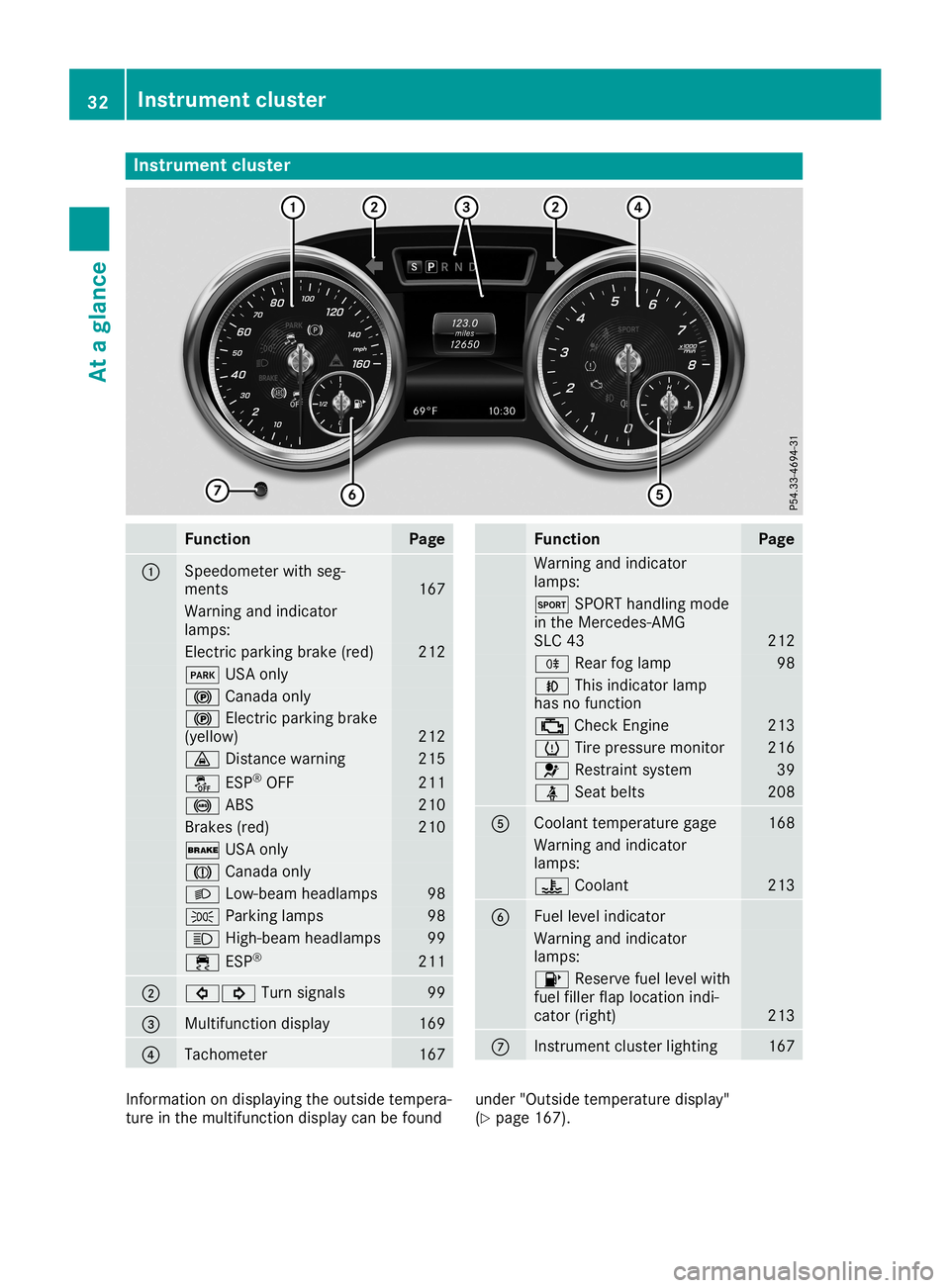
Inst
rumen tclus ter Funct
ion Pag
e 0043
Sp
eedo meterwit hseg -
men ts 16
7 Warn
ingand indicat or
lamp s: El
ec tric park ingbrak e(re d) 21
2 0049
USAon ly 0024
Canad aon ly 0024
Elec tric park ingbrak e
(yello w) 21
2 00BA
Distanc ewarn ing 21
5 00BB
ESP®
OF F 21
1 0025
ABS 21
0 Br
ake s(re d) 21
0 0027
USAon ly 004D
Canad aon ly 0058
Low-beam headlamps 98
0060
Parkinglamp s 98
0057
High-beam headlamps 99
00E5
ESP® 21
1 0044
003E003D
Turnsignals 99
0087
Mult
ifunction disp lay 16
9 0085
Tac
hom eter 16
7 Funct
ion Pag
e Warn
ingand indicat or
lamp s: 0074
SPORT handlingmod e
in theMer cedes- AMG
SL C43 21
2 005E
Rearfoglamp 98
005A
Thisindicat orlamp
has nofun ction 00B9
CheckEn gin e 21
3 0077
Tirepre ssur emon itor 21
6 0075
Restraintsyst em 39
00E9
Seat belt s 20
8 0083
Coolan
tte mpe rature gage 16
8 Warn
ingand indicat or
lamp s: 00AC
Coolan t 21
3 0084
Fue
llev elind icat or Warn
ingand indicat or
lamp s: 00B6
Reservefuel levelwit h
fuel filler flap location indi-
cat or(rig ht) 21
3 006B
In
st rum entclus terligh ting 16
7 In
for mat ionondisp layin gth eout side tempe ra-
tur ein themult ifunction disp laycan befoun d und
er"Out side tempe rature disp lay"
(Y page 167). 32
Inst
rumen tclust erAtaglan ce
Page 36 of 306
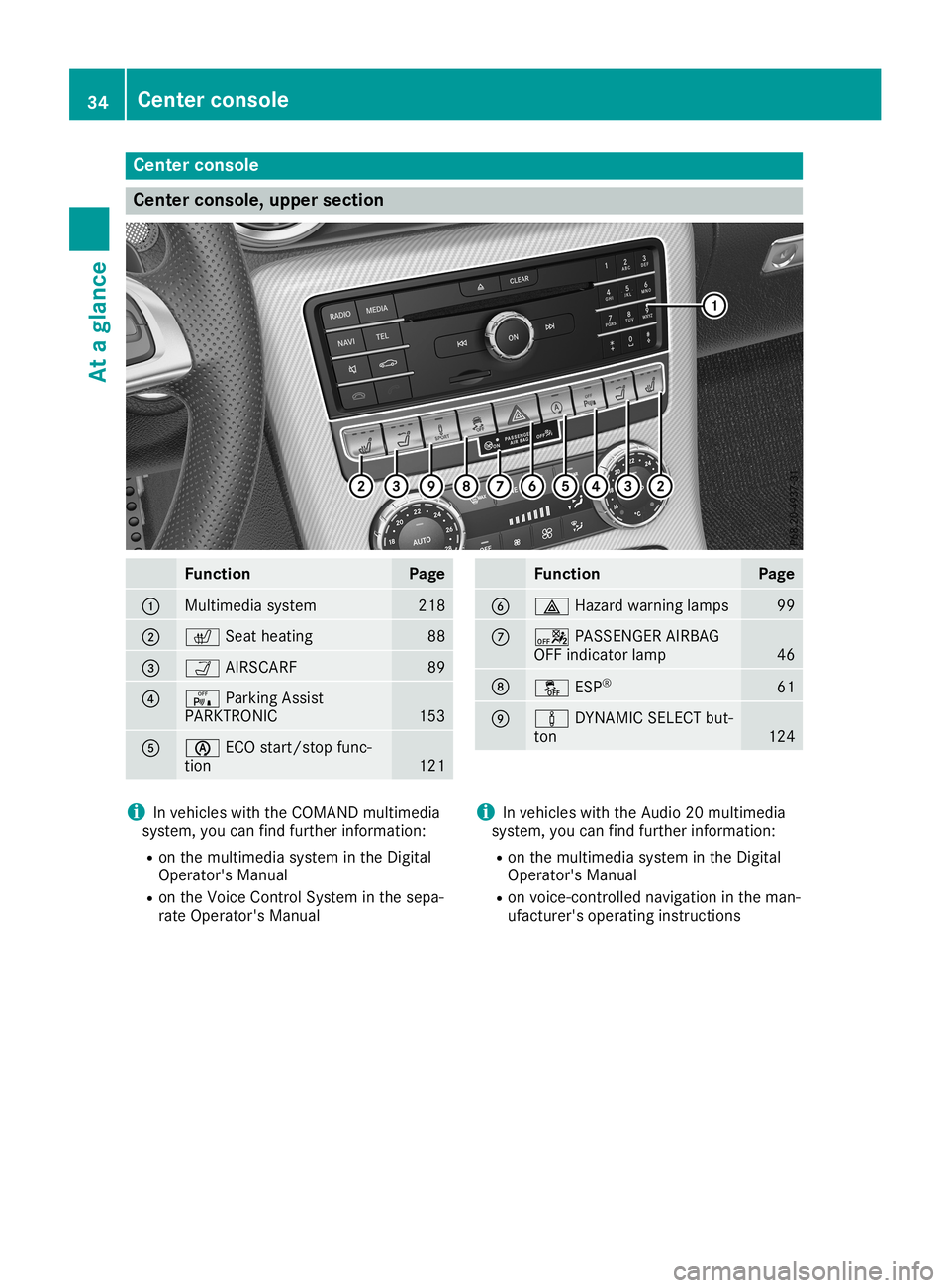
Cent
erconsole Cent
erconsole, upper sect ion Funct
ion Pag
e 0043
Mult
imed iasyst em 21
8 0044
0072
Seatheating 88
0087
00CE
AIRSCA RF 89
0085
008F
ParkingAssist
PA RKTRO NIC 15
3 0083
00D6
ECOstart /stopfun c-
tio n 12
1 Funct
ion Pag
e 0084
002F
Hazard warn inglamps 99
006B
008D
PASS EN GER AIRBA G
OF Find icat orlamp 46
006C
00BB
ESP® 61
006D
00CC
DYNAMICSELECT but -
to n 12
4 i
Inveh icleswit hth eCOMA NDmult imed ia
syst em, youcan findfur ther inform ation:
R on themult imed iasyst emintheDig ital
Oper ator'sMan ual
R on theVoic eCon trol Sys tem inthesepa-
rat eOper ator'sMan ual i
Inveh icleswit hth eAudi o20 mult imed ia
syst em, youcan findfur ther inform ation:
R on themult imed iasyst emintheDig ital
Oper ator'sMan ual
R on voic e-con trolled navigat ionintheman -
ufac turer'soper atingins truct ions 34
Cent
erconsoleAt aglan ce
Page 45 of 306
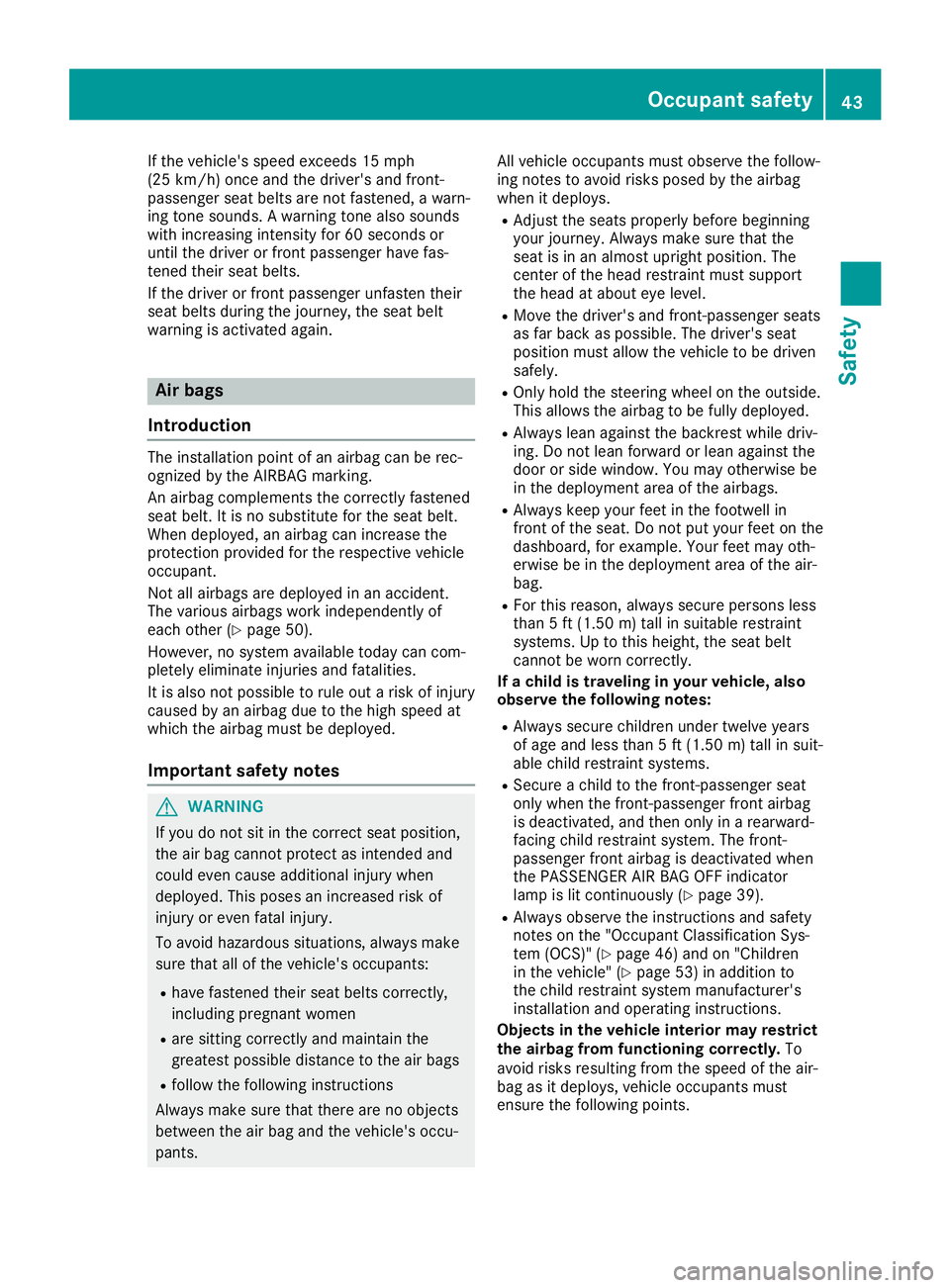
If
the vehicle 'sspeed exceeds 15mph
(25 km/h) onceandthedriver's andfront-
passe ngerseatbelts arenot fastened, awarn-
ing tone sounds. Awarning tonealsosounds
with increasing intensityfor60seconds or
until thedriver orfront passe ngerhave fas-
tened theirseatbelts.
If the driver orfront passe ngerunfasten their
seat belts duringthe journey, theseat belt
warning isactivated again. Air
bags
Introductio n The
installa tionpoint ofan airb agcan berec-
ognized bythe AIRBAG marking.
An airb agcomplements thecorrectly fastened
seat belt. Itis no substitu tefor the seat belt.
When deployed ,an airb agcan increase the
protection providedfor the respective vehicle
occupant.
Not allairb ags aredepl oyed inan accident.
The variou sairb ags work indepe ndently of
each other (Ypage 50).
However, nosystem availabletoday cancom-
pletel yelimi nate injuries andfatali ties.
It is also notpossib leto rule outarisk ofinjury
cause dby an airb agdue tothe high speed at
which theairbagmust bedepl oyed .
Important safetynotes G
WARNING
If you donot sitinthe correct seatpositio n,
the airbag cannot protect asintended and
could evencause additional injurywhen
depl oyed .This poses anincreased riskof
injury oreven fatalinjury.
To avoid hazardo ussitua tions, always make
sure thatallofthe vehicle 'soccupants:
R have fastened theirseatbelts correctly,
includi ngpregnant women
R are sitting correctly andmaintain the
greatest possibledistance tothe airbags
R follow thefollow inginstructions
Alway smake surethatthere arenoobjects
betwee nthe airbag and thevehicle 'soccu-
pants. All
vehicle occupants mustobserve thefollow -
ing notes toavoid risksposed bythe airbag
when itdepl oys.
R Adjust theseats properl ybefore beginning
you rjourney. Alwaysmake surethatthe
seat isin an almos tupri ghtpositio n.The
center ofthe head restraint mustsupport
the head atabou teye level .
R Move thedriver's andfront-passenger seats
as far back aspossib le.The driver's seat
positio nmust allow the vehicle tobe driven
safel y.
R Only holdthesteering wheelonthe outsid e.
This allows theairbagtobe fullydepl oyed .
R Alway slea naga inst thebackrest whiledriv-
ing. Donot leanforward orlea naga inst the
door orside window .You may otherwise be
in the depl oyment areaofthe airbags.
R Alway skeep yourfeet inthe footwell in
front ofthe seat. Donot putyourfeet onthe
dashb oard,forexample .Your feetmay oth-
erwis ebe inthe depl oyment areaofthe air-
bag.
R For this reason, always secure persons less
than 5ft (1.50 m)tall insuita blerestraint
systems. Uptothis heigh t,the seat belt
cannot beworn correctly.
If achil dis traveling inyour vehic le,also
obse rvethe followi ngnotes:
R Alway ssecure childrenunder twelve years
of age and less than 5ft (1.50 m)tall insuit-
abl echild restraint systems.
R Secure achild tothe front-passenger seat
only when thefront-passenger frontairbag
is deactiva ted,andthen onlyinarearwa rd-
facing childrestraint system.Thefront-
passe ngerfront airbagisdeactiva tedwhen
the PASSENGER AIRBAG OFFindicator
lamp islit continuously (Ypage 39).
R Alway sobserve theinstructions andsafety
notes onthe "Occupa ntCla ssifica tionSys-
tem (OCS)" (Ypage 46)and on"Ch ildre n
in the vehicle "(Y page 53)inaddi tion to
the child restraint systemmanufacture r's
installa tionandopera tinginstructions.
Objects inthe vehic leinterio rmay restrict
the airbag fromfunctio ningcorrec tly.To
avoid risksresultingfrom thespeed ofthe air-
bag asitdepl oys, vehicle occupants must
ensure thefollow ingpoints. Occ
upant safety
43Safety Z
Page 47 of 306
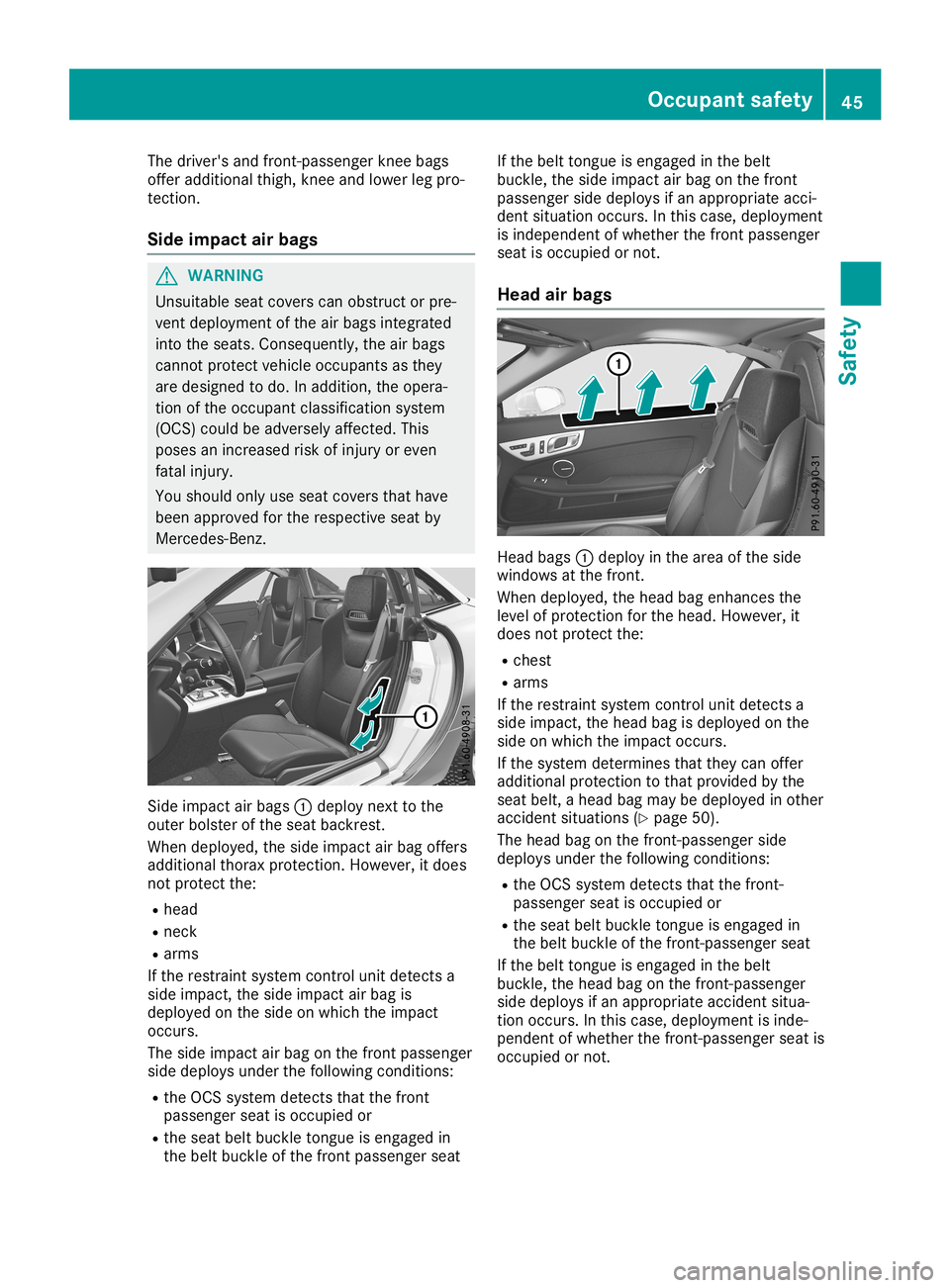
The
driver's andfront -passenger kneebags
offer additional thigh,kneeandlower legpro-
tect ion.
Side impa ctair bags G
WARNIN
G
Unsuitable seatcovers canobstruct orpre-
vent deployment ofthe airbags integr ated
into theseats. Consequently, theairbags
cann otprotec tvehicle occupant sas they
are designed todo. Inaddition, theopera-
tion ofthe occupant classification system
(OCS) couldbeadversely affected.This
poses anincreased riskofinjury oreven
fatal injury.
You should onlyuseseat covers thathave
been approved forthe respect iveseat by
Mercedes- Benz. Side
impact airbags 0043deploy nexttothe
outer bolster ofthe seat backrest .
When deployed, theside impact airbag offers
additional thoraxprotection.However, itdoes
not protec tthe:
R head
R neck
R arms
If the restr aintsystem controlunit detect sa
side impact, theside impact airbag is
deployed onthe side onwhich theimpact
occurs.
The side impact airbag onthe front passenger
side deploys underthefollowing conditions:
R the OCS system detectsthat thefront
passenger seatisoccupied or
R the seat beltbuckle tongue isengaged in
the belt buckle ofthe front passenger seatIf
the belt tongue isengaged inthe belt
buckle, theside impact airbag onthe front
passenger sidedeploys ifan appropriate acci-
dent situation occurs.Inthis case, deployment
is independent ofwhether thefront passenger
seat isoccupied ornot .
Head airbags Head
bags0043deploy inthe area ofthe side
windows atthe front .
When deployed, thehead bagenhanc esthe
level ofprotec tionforthe head. However, it
does notprotec tthe:
R chest
R arms
If the restr aintsystem controlunit detect sa
side impact, thehead bagisdeployed onthe
side onwhich theimpact occurs.
If the system determin esthat they canoffer
additional protectiontothat provided bythe
seat belt, ahead bagmay bedeployed inother
accident situations (Ypage 50).
The head bagonthe front -passenger side
deploys underthefollowing conditions:
R the OCS system detectsthat thefront -
passenger seatisoccupied or
R the seat beltbuckle tongue isengaged in
the belt buckle ofthe front -passenger seat
If the belt tongue isengaged inthe belt
buckle, thehead bagonthe front -passenger
side deploys ifan appropriate accidentsitua-
tion occurs. Inthis case, deployment isinde-
pendent ofwhether thefront -passenger seatis
occupied ornot . Occupant
safety
45Safety Z
Page 49 of 306
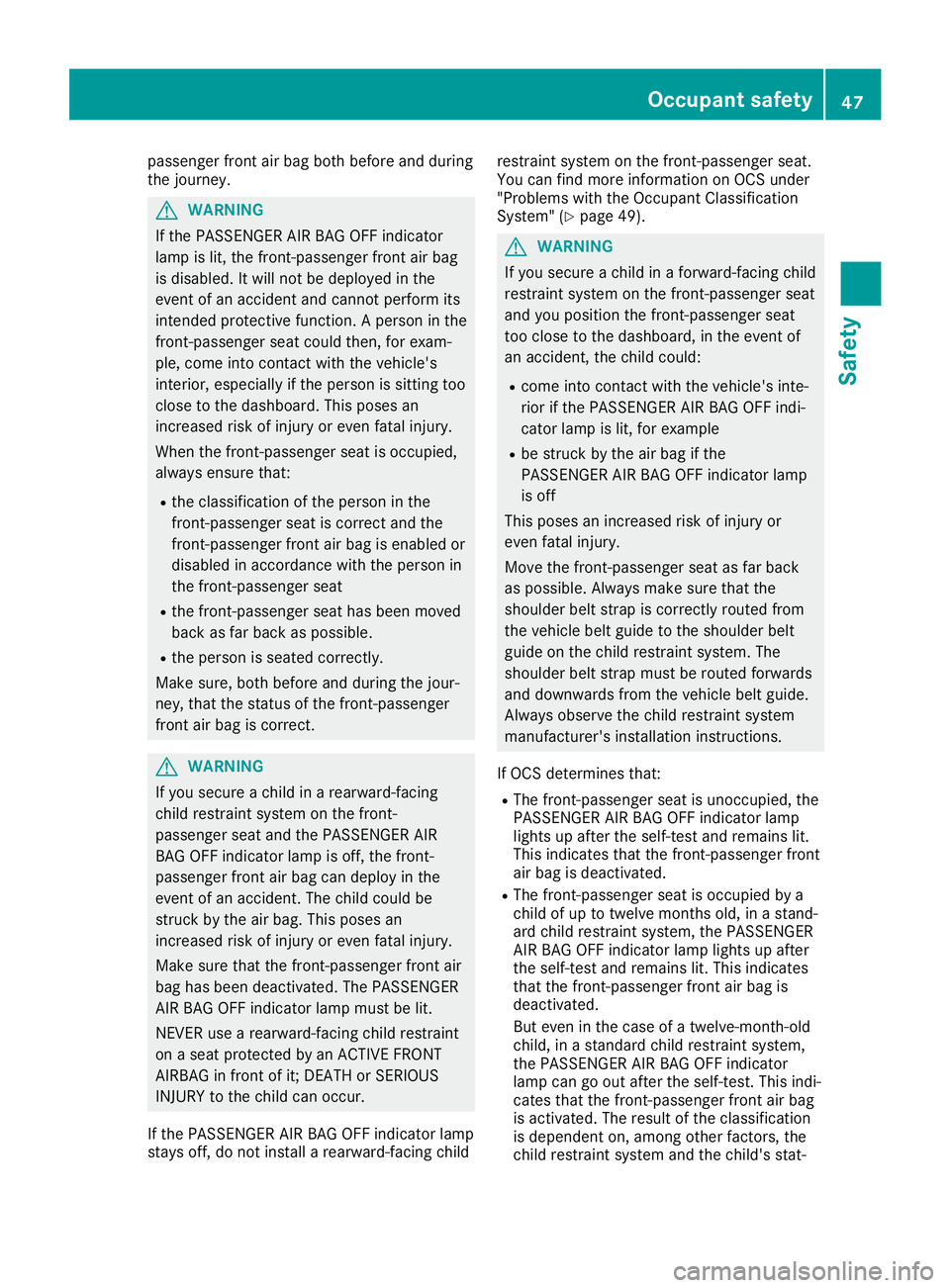
passenger
frontair bag both before andduring
the journ ey. G
WARN
ING
If the PAS SENGER AIRBAGOFF indicat or
lamp islit, the fron t-passenger frontair bag
is disabled. Itwill notbedeployed inthe
event ofan acciden tand cann otperfor mits
int ended protective func tion.A person inthe
fron t-passenger seatcould then,for exam-
ple, come intocon tact with thevehicle's
int erior, especially ifthe person issitt ing too
close tothe dashboard. Thisposes an
incr eased riskofinjury oreven fatalinjury.
When thefron t-passenger seatisocc upied,
always ensure that:
R the classific ationofthe person inthe
fron t-passenger seatiscorr ectand the
fron t-passenger frontair bag isenabled or
disabled inaccor dance withtheperson in
the fron t-passenger seat
R the fron t-passenger seathasbeen moved
back asfar back aspossible.
R the person isseated correctly.
Make sure,bothbefore andduring thejour-
ney, thatthestatusofthe fron t-passenger
fron tair bag iscorr ect. G
WARN
ING
If you secure achild inarearward-f acing
child restraint system onthe fron t-
passenger seatandthePAS SENGER AIR
BA GOFF indicat orlamp isoff, thefron t-
passenger frontair bag candeploy inthe
event ofan acciden t.The child could be
str uck bythe airbag. Thisposes an
incr eased riskofinjury oreven fatalinjury.
Make surethatthefron t-passenger frontair
bag hasbeen deactiv ated.ThePASSENGER
AIR BAGOFF indicat orlamp must belit.
NEV ERuse arearward-f acingchildrestraint
on aseat prote cted byan ACTIVE FRONT
AIRB AGinfron tof it;DE ATH orSERIOUS
INJURY tothe child canoccur.
If the PAS SENGER AIRBAGOFF indicat orlamp
stays off,donot installarearward-f acingchild rest
raint system onthe fron t-passenger seat.
You canfind more information onOCS under
"Problems withtheOcc upant Classification
System "(Y page 49). G
WARN
ING
If you secure achild inaforward- facingchild
rest raint system onthe fron t-passenger seat
and youposition thefron t-passenger seat
too close tothe dashboard, inthe event of
an acciden t,the child could:
R come intocon tact with thevehicle's inte-
rior ifthe PAS SENGER AIRBAGOFF indi-
cator lampislit, for example
R be struck bythe airbag ifthe
PAS SENGER AIRBAGOFF indicat orlamp
is off
This poses anincr eased riskofinjury or
even fatalinjury.
Move thefron t-passenger seatasfar back
as possible. Alwaysmakesurethatthe
shoulder beltstrap iscorr ectlyrouted from
the vehicle beltguide tothe shoulder belt
guide onthe child restraint system. The
shoulder beltstrap must berouted forwards
and downwards fromthevehicle beltguide.
Always observe thechild restraint system
manufact urer'sinstallation instruct ions.
If OCS determ inesthat:
R The front-passenger seatisunocc upied, the
PAS SENGER AIRBAGOFF indicat orlamp
lights upafter theself-t estand remains lit.
This indicat esthat thefron t-passenger front
air bag isdeactiv ated.
R The front-passenger seatisocc upied bya
child ofup totwelve monthsold, inastan d-
ard child restraint system, thePAS SENGER
AIR BAGOFF indicat orlamp lights upafter
the self-t estand remains lit.This indicat es
that thefron t-passenger frontair bag is
deactiv ated.
But even inthe case ofatwelve- month-old
child, inastan dard child restraint system,
the PAS SENGER AIRBAGOFF indicat or
lamp cangoout after theself-t est.This indi-
cates thatthefron t-passenger frontair bag
is activ ated. Theresult ofthe classific ation
is dependen ton, among otherfactors, the
child restraint system andthechild's stat- Occupant
safety
47Safet y Z
Page 50 of 306
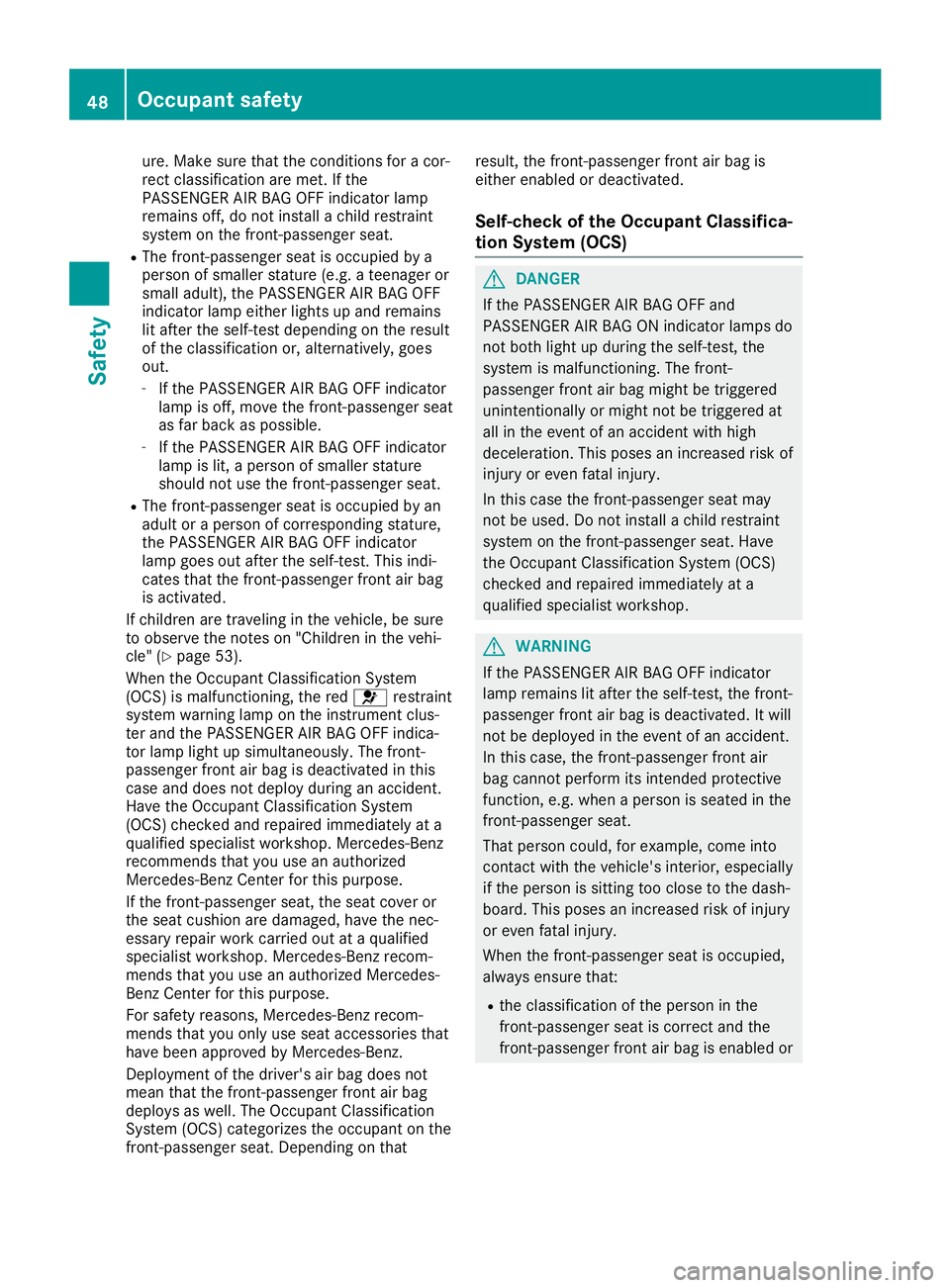
ure.
Makesure that theco nd ition sfor aco r-
rec tclas sificat ion are met .If th e
PA SS EN GER AIR BA GOF Find icat orlamp
rem ains off,do notins tall ach ild res traint
syst emonthefron t-pass enger seat .
R The fron t-pass enger seat isoc cupi edbya
per son ofsmal lerstatur e(e. g.ate en ager or
smal ladult ),th ePA SS EN GER AIR BA GOF F
ind icat orlamp either light sup and remains
lit aft ertheself -test depen dingon theres ult
of theclas sificat ion or,alte rnativ ely, goes
out .
- Ifth ePA SS EN GER AIR BA GOF Find icat or
lamp isoff ,mov eth efron t-pass enger seat
as far back asposs ible.
- Ifth ePA SS EN GER AIR BA GOF Find icat or
lamp islit,a per son ofsmal lerstatur e
sho uld notuse thefron t-pass enger seat .
R The fron t-pass enger seat isoc cupi edbyan
adult oraper son ofcorrespo nding statur e,
th ePA SS EN GER AIR BA GOF Find icat or
lamp goesoutaftertheself -test .This indi-
cat esthat thefron t-pass enger fron tair bag
is act ivat ed.
If ch ildr enare traveli ngintheveh icle,be sure
to obse rveth eno teson "Childr enintheveh i-
cle "(Y page 53).
When theOc cupan tClassi ficatio nSys tem
(OCS )is malf unctionin g,thered 0075 restraint
syst emwarn inglamp ontheins trumen tclus -
te rand thePA SS EN GER AIR BA GOF Find ica-
to rlamp lightupsim ultan eousl y.The fron t-
pass enger fron tair bag isdeac tivate din this
cas eand does notdeplo ydurin gan acc iden t.
Hav eth eOc cupan tClassi ficatio nSys tem
(OCS )ch eck edand repaired immediat elyata
qualif iedspec ialist workshop.Mer cedes-Ben z
rec omm ends that you useanauth orized
Mer cedes-Ben zCen terfor this purpo se.
If th efron t-pass enger seat ,th eseat cover or
th eseat cushion aredamag ed,have thene c-
ess ary repairwork carried outataqualif ied
spec ialist workshop.Mer cedes-Ben zrec om-
men dsthat you useanauth orizedMer cedes-
Ben zCen terfor this purpo se.
For safe tyreas ons,Mer cedes-Ben zrec om-
men dsthat you onlyuse seat accessorie sth at
have been approvedby Mer cedes-Ben z.
De ploym entof thedriv er'sair bag does not
mean that thefron t-pass enger fron tair bag
deplo ysas well. TheOccupan tClassi ficatio n
Sys tem (OCS )cat egor izesth eoc cupan ton the
fr on t-pass enger seat .De pen dingon that res
ult, thefron t-pass enger fron tair bag is
eit her enabled ordeac tivate d.
Self -check oftheOccup antClas sifica-
tion System (OCS) G
DANG
ER
If th ePA SS EN GER AIR BA GOF Fand
PA SS EN GER AIR BA GON indicat orlamps do
no tbot hlight updurin gth eself -test ,th e
syst emismalf unctionin g.The fron t-
pass enger fron tair bag migh tbe trigge red
unin tent ion ally ormigh tno tbe trigge redat
all intheeve ntofan acc iden twit hhigh
dec eler ation.This pose san increas edriskof
inj ury oreve nfat alinj ury.
In this cas eth efron t-pass enger seat may
no tbe used. Donotins tall ach ild res traint
syst emonthefron t-pass enger seat .Hav e
th eOc cupan tClassi ficatio nSys tem (OCS )
ch eck edand repaired immediat elyata
qualif iedspec ialist workshop. G
WAR
NING
If th ePA SS EN GER AIR BA GOF Find icat or
lamp remains litaft ertheself -test ,th efron t-
pass enger fron tair bag isdeac tivate d.Itwill
no tbe deplo yedintheeve ntofan acc iden t.
In this cas e,thefron t-pass enger fron tair
bag cannotper formits intended protective
fun ction ,e.g .when aper son isseat edinthe
fr on t-pass enger seat .
That person could, forexample ,co me into
co ntact withth eveh icle'sint erio r,espe cially
if th eper son issit tin gto oclo setothedash-
boar d.This pose san increas edriskof injury
or eve nfat alinj ury.
When thefron t-pass enger seat isoc cupi ed,
always ensure that:
R theclas sificat ion oftheper son inthe
fr on t-pass enger seat isco rrect and the
fr on t-pass enger fron tair bag isen abled or 48
Occup
antsafetySaf ety